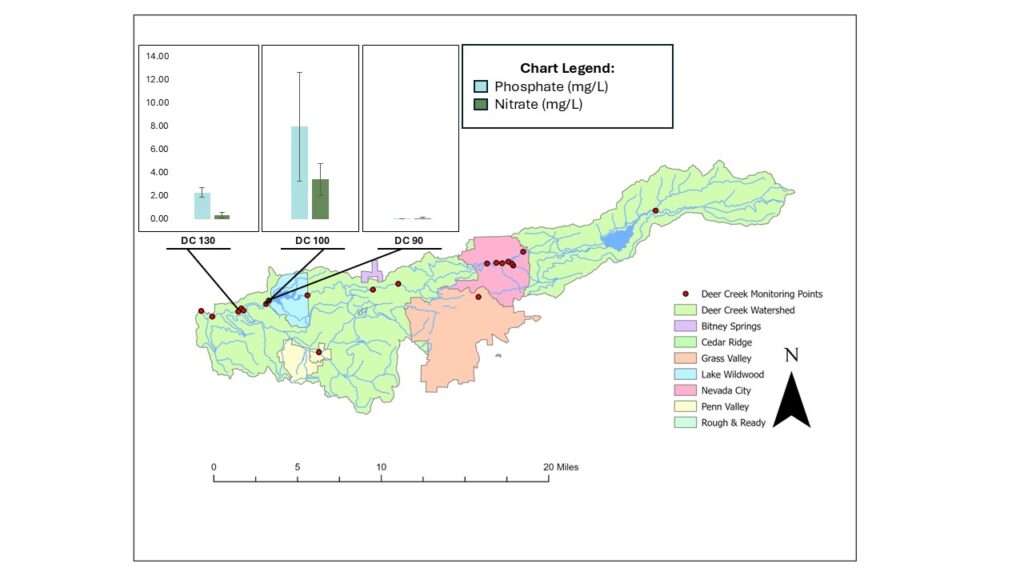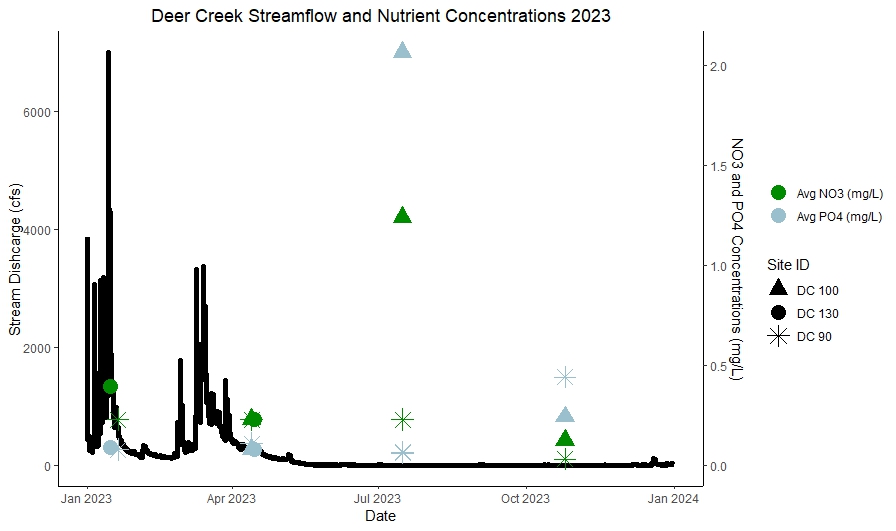This summer SSI staff and volunteers took to the lower Deer Creek Watershed to investigate nutrients, namely nitrates and phosphates. Nutrients are essential for life in a creek, but in excess, they can lead to overgrowth of algae and low-oxygen conditions (read more about how that happens here; scroll down to the eutrophication section).
There are two Wastewater Treatment Plants that discharge into Deer Creek. While the discharge tends to have higher levels of nutrients than natural creek water, this is not a problem if there is a lot of water in the creek to dilute the discharge. However, it becomes a problem when there is not much water in the creek to start with, like in the lower Deer Creek Watershed in the late summer, when releases from Lake Wildwood are small. To determine the impact of the treatment plant on nutrient levels in the creek, we went out four times between late August and early September, and averaged the results for each site.
The graphic below compares nitrates and phosphates in Deer Creek at three sites below Lake Wildwood:
- DC 90 is just below the Lake Wildwood weir, so it measures nutrients coming from the lake.
- DC 100 is just below the Lake Wildwood Water Treatment Plant, so it measures the addition of nutrients from the discharge.
- DC 130 is further downstream, near the confluence with the Yuba River, so it is an indication of how far downstream the nutrient impact can be seen.

Figure 1: Nitrate and phosphate levels at three sites on Deer Creek below Lake Wildwood.
In the figure above, we see very low levels of nutrients coming out of Lake Wildwood (DC 90), which is on par with other sections of Deer Creek around this time. We see high levels of nutrients coming out of the Wastewater Treatment Plant (DC 100), about 50 to 80 times the level we see in natural creek water this time of year (for example, above the dam we see phosphate and nitrate levels around 0.05-0.1 milligrams per liter). Nutrient levels (especially nitrates) were a little lower but still quite elevated 3 miles downstream at DC 130.

Figure 2: One year of flow in Deer Creek below Lake Wildwood, with nutrient levels plotted as well. In general, at lower flows we see higher levels of nitrates and phosphates.
Wastewater Treatment Plants are held to some strict regulations regarding what can be present in their discharge, but it tends to be based on human health rather than environmental health. The only nutrient regulation is for nitrate and it’s set at 10 milligrams per liter, because levels above that could be harmful to humans if they were to drink the water. The treatment plant above DC 100 is maintaining levels well below this limit. However, that amount of nitrate is about 100 times more than a natural creek system would ever see, and it throws off a delicate balance of growth in the creek. There is currently no limit on the amount of phosphate that can be present in discharge, and we’ve seen up to 16 milligrams per liter in the late summer. There is heavy algae overgrowth in lower Deer Creek in the summer, likely due to this nutrient imbalance.
If you’re interested in learning more about our target monitoring, or helping by joining our targeted monitoring team, reach out! Contact lab@sierrastreamsinstitute.org for more.

